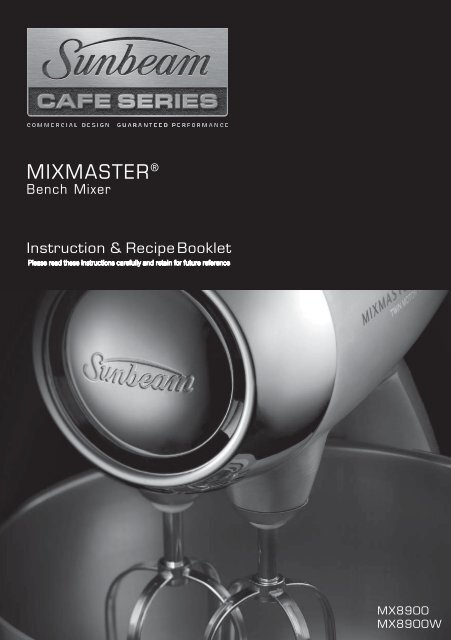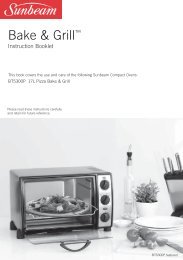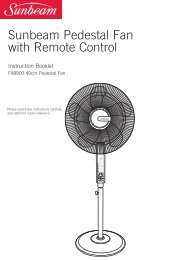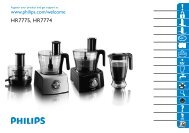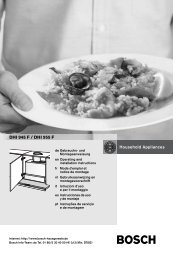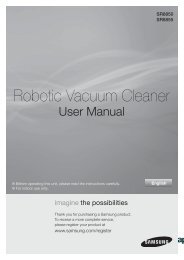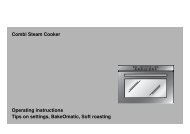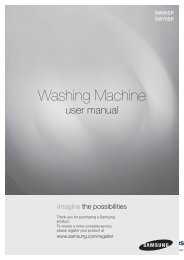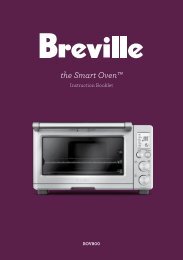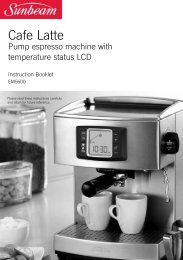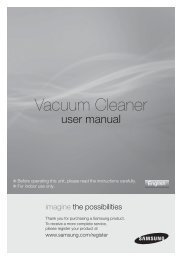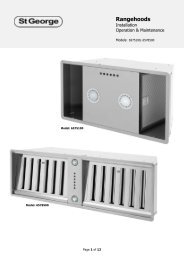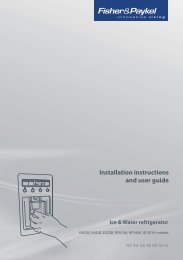Manual (pdf) - Sunbeam
Manual (pdf) - Sunbeam
Manual (pdf) - Sunbeam
You also want an ePaper? Increase the reach of your titles
YUMPU automatically turns print PDFs into web optimized ePapers that Google loves.
MIXMASTER ®<br />
Bench Mixer<br />
Instruction & Recipe Booklet<br />
MX8900<br />
MX8900W
Contents<br />
<strong>Sunbeam</strong>’s Safety Precautions 2<br />
Congratulations 3<br />
Features of your Café Series ® Mixmaster ® 4<br />
Using your Café Series ® Mixmaster ® 6<br />
Role of the twin-motor 3-way beating action 9<br />
Mixing guide 10<br />
Oven temperature guide 11<br />
Care and cleaning 12<br />
Lets talk ingredients 13<br />
Cookery tips for best results 15<br />
Helpful hints for a successful dough 16<br />
Helpful hints for better cake making 18<br />
Recipes – Baking 20<br />
Brunch, Lunchtime and Afternoon Tea 26<br />
Pre-Dinner Nibbles 27<br />
After Dinner 29<br />
Kids Treats 32<br />
Special Occasions 35<br />
Important instructions – retain for<br />
future use.<br />
1
2<br />
<strong>Sunbeam</strong>’s Safety Precautions<br />
SAFETY PRECAUTIONS FOR YOUR<br />
SUNBEAM MIXMASTER BENCH MIXER.<br />
• Never eject beaters, dough hooks or whisks<br />
when the appliance is in operation.<br />
• Ensure fingers are kept well away from moving<br />
beaters, whisks and dough hooks.<br />
• Ensure that the bowl is secured and locked<br />
onto the base of the mixer before commencing<br />
mixing.<br />
• Do not unlock or remove the mixing bowl from<br />
the base of the mixer whilst mixer is in use.<br />
<strong>Sunbeam</strong> is very safety conscious when designing and<br />
manufacturing consumer products, but it is essential<br />
that the product user also exercise care when using<br />
an electrical appliance. Listed below are precautions<br />
which are essential for the safe use of an electrical<br />
appliance:<br />
• Read carefully and save all the instructions provided<br />
with an appliance.<br />
• Always turn the power off at the power outlet before<br />
you insert or remove a plug. Remove by grasping the<br />
plug - do not pull on the cord.<br />
• Turn the power off and remove the plug when the<br />
appliance is not in use and before cleaning.<br />
• Do not use your appliance with an extension cord<br />
unless this cord has been checked and tested by a<br />
qualified technician or service person.<br />
• Always use your appliance from a power outlet of the<br />
voltage (A.C. only) marked on the appliance.<br />
• This appliance is not intended for use by persons<br />
(including children) with reduced physical, sensory<br />
or mental capabilities, or lack of experience and<br />
knowledge, unless they have been given supervision<br />
or instruction concerning use of the appliance by a<br />
person responsible for their safety.<br />
• Children should be supervised to ensure that they do<br />
not play with the appliance.<br />
• The temperature of accessible surfaces may be high<br />
when the appliance is operating.<br />
• Never leave an appliance unattended while in use.<br />
• Should you be using a spatula during mixing,<br />
ensure that the spatula is kept well away from<br />
moving beaters, whisks and dough hooks.<br />
• Never tilt back the head of the mixer whilst the<br />
appliance is in operation.<br />
• When using extremely heavy loads the<br />
appliance should not be operated for more<br />
than 1 minute 30 seconds. This does not<br />
apply to the recipes detailed in this booklet.<br />
• Ensure long hair is tied back and young<br />
children are not near the moving bowl.<br />
• Do not use an appliance for any purpose other than<br />
its intended use.<br />
• Do not place an appliance on or near a hot gas<br />
flame, electric element or on a heated oven.<br />
• Do not place on top of any other appliance.<br />
• Do not let the power cord of an appliance hang over<br />
the edge of a table or bench top or touch any hot<br />
surface.<br />
• Do not operate any electrical appliance with a<br />
damaged cord or after the appliance has been<br />
damaged in any manner. If damage is suspected,<br />
return the appliance to the nearest <strong>Sunbeam</strong><br />
Appointed Service Centre for examination, repair or<br />
adjustment.<br />
• For additional protection, <strong>Sunbeam</strong> recommend<br />
the use of a residual current device (RCD) with a<br />
tripping current not exceeding 30mA in the electrical<br />
circuit supplying power to your appliances.<br />
• Do not immerse the appliance in water or any other<br />
liquid unless recommended.<br />
• Appliances are not intended to be operated by<br />
means of an external timer or separate remote<br />
control system.<br />
• This appliance is intended to be used in household<br />
and similar applications such as: staff kitchen areas<br />
in shops, offices and other working environments;<br />
farm houses; by clients in hotels, motels and other<br />
residential type environments; bed and breakfast<br />
type environments.<br />
If you have any concerns regarding the performance and use of your appliance,<br />
please visit www.sunbeam.com.au or contact the <strong>Sunbeam</strong> Consumer Service Line.<br />
Ensure the above safety precautions are understood.
Congratulations<br />
Congratulations on the purchase of your<br />
<strong>Sunbeam</strong> Café Series ® Mixmaster ®<br />
Bench Mixer.<br />
The <strong>Sunbeam</strong> Café Series ® delivers quality,<br />
style and superior performance capturing<br />
the essence of the commercial kitchen.<br />
Inspired by heavy-duty equipment found in<br />
restaurants, cafes and bars, the <strong>Sunbeam</strong><br />
Café Series ® is built to last. It brings<br />
together a range of appliances designed<br />
to expertly create authentic café food and<br />
beverages at home.<br />
Uncompromising blends of stainless steel,<br />
brass and die-cast alloy characterise the<br />
range. This combined with advanced<br />
technology and functional design, guarantee<br />
the performance, that each product will<br />
surpass expectations.<br />
The <strong>Sunbeam</strong> Series ® Mixmaster ® Bench<br />
Mixer is designed with quality die-cast metal<br />
components and includes many features that<br />
make mixing at home easy.<br />
3
4<br />
Features of your Café Series ®<br />
Mixmaster ®<br />
Attachment eject button<br />
The eject button, located on the top of the<br />
handle releases the beaters, dough hooks or<br />
whisks for easy cleaning.<br />
Twin-motor 3-way beating action<br />
Patent pending twin-motor design enables one<br />
motor to drive the beaters, each turning in<br />
opposite directions. The second motor drives the<br />
bowl, thus combined, this new technology results<br />
in a more powerful and thorough mixing result.<br />
Variable bowl speed<br />
The bowl speed increases and decreases<br />
automatically as the beater speed is increased<br />
and decreased.<br />
Off-centre head & beaters<br />
The head of the mixer and beaters are positioned<br />
off-centre to make it easier to add ingredients<br />
during mixing.<br />
Tilt back locking head<br />
The head of the mixer tilts back and locks<br />
securely into position to allow easy removal of<br />
mixing bowls and attachments.<br />
Bowl selector<br />
Simply slide the bowl selector lever to the left<br />
when using the small bowl and to the right when<br />
using the large bowl.
Stainless steel wire whisks<br />
For whisking cream, egg whites, light batters and<br />
packet cake mixes.<br />
Stainless steel 'V-groove' beaters<br />
Heavy duty 'V-groove' beaters for creaming butter<br />
and sugar, plus mixing heavy cake mixes.<br />
Stainless steel dough hooks<br />
Heavy duty dough hooks take the hard work out<br />
of kneading dough and other heavy mixtures.<br />
12 electronic speeds<br />
The combination of 12 electronic speeds and a<br />
powerful torque control motor ensures superior<br />
mixing control and maintains speed regardless of<br />
the mixing load.<br />
Stainless steel mixing bowls<br />
4.4 and 2.1 litre mixing bowls are ideal for<br />
mixing large or small quantities of ingredients.<br />
Die-cast metal body<br />
The heavy duty die-cast metal body combined<br />
with non-slip rubber feet keep the mixer stable<br />
during operation.<br />
5
6<br />
Using your Café Series ® Mixmaster ®<br />
Before using your Mixmaster ® Bench Mixer<br />
Before assembling your mixer, be sure the<br />
power cord is unplugged from the power<br />
outlet and the speed control dial is in the<br />
'Off' position.<br />
1. Press the 'tilt' button, located at the top<br />
of the neck of the mixer. While the button<br />
is depressed, hold the handle (1) and ease<br />
the head of the mixer back. The mixer<br />
head will lock into this tilt position (2).<br />
2.Select the desired attachments depending<br />
(1)<br />
(2)<br />
on the mixing task to be performed;<br />
TILT<br />
BUTTON<br />
– Beaters for creaming butter and sugar,<br />
plus mixing heavy cake mixes.<br />
– Whisks for whisking cream, egg whites,<br />
light batters and packet cake mixes.<br />
– Dough hooks for kneading dough and<br />
other heavy mixtures.<br />
3.Insert selected attachment;<br />
Beaters – select the two beaters.<br />
Take the beater that has a pointier,<br />
curved bottom and has a red<br />
coloured band around the top<br />
A B<br />
of the beater – illustrated as beater (A).<br />
Insert beater (A) into the left hole on the<br />
underside of the mixer head, the hole is<br />
identified by a red dot beside it (3).<br />
Take the beater with the angular/flat<br />
bottom, illustrated as beater (B) and insert<br />
into the remaining hole.<br />
Note: Be sure both beaters click firmly in<br />
place, you may need to twist the beater<br />
slightly to engage it in position prior to<br />
pushing it in place.<br />
A<br />
B<br />
Whisks – select the two whisks.<br />
Take the whisk that has a curved<br />
bottom and has a red coloured<br />
band around the top of the<br />
A B<br />
whisk – illustrated as whisk (A).<br />
Insert whisk (A) into the left hole on the<br />
underside of the mixer head, the hole is<br />
identified by a red dot beside it (4).<br />
Take the whisk with the angular/flat<br />
bottom, illustrated as whisk (B) and insert<br />
into the remaining hole.<br />
Note: Be sure both whisks click firmly in<br />
place, you may need to twist the whisk<br />
slightly to engage it in position prior to<br />
pushing it in place.<br />
(3)
Using your Café Series ® Mixmaster ® continued<br />
(4)<br />
Dough hooks – select the two dough<br />
hooks. Take the dough hook that<br />
is hooked at the bottom and has a<br />
red coloured band around the top<br />
A B<br />
of the dough hook – illustrated as<br />
dough hook (A). Insert dough hook (A) into<br />
the left hole on the underside of the mixer<br />
head, the hole is identified by a red dot<br />
beside it (5).<br />
(5)<br />
A<br />
Take the dough hook that is straight at the<br />
bottom, illustrated as dough hook (B) and<br />
insert into the remaining hole.<br />
Note: Be sure both dough hooks click<br />
firmly in place, you may need to twist the<br />
dough hook slightly to engage it in position<br />
prior to pushing it in place.<br />
A<br />
B<br />
Important: These attachments have been<br />
designed with a safety feature so that they<br />
cannot be put in, in the incorrect way.<br />
B<br />
4.Depending on the amount of ingredients<br />
required for mixing, select bowl size. If<br />
you have selected the large 4.4 litre bowl,<br />
slide the bowl selector to the far right (6a).<br />
If you have selected the smaller 2.1 litre<br />
bowl, slide the bowl selector to the far left<br />
(6b).<br />
(6a)<br />
(6b)<br />
5.Once you have selected the bowl you wish<br />
to use, place it on the rotating base.<br />
Gently rotate the bowl in an anti-clockwise<br />
direction until it drops into position or<br />
is sitting flat (a). Then rotate the bowl<br />
clockwise to lock it into position (b).<br />
The bowl should feel firm with no<br />
movement (7).<br />
(a)<br />
(b)<br />
(7)<br />
7
8<br />
Using your Café Series ® Mixmaster ® continued<br />
6.Lower the head with the selected<br />
attachments (either, beaters, whisks or<br />
dough hooks) in place, into the mixing<br />
bowl. To do this press the 'tilt' button.<br />
While the button is depressed hold the<br />
handle (8) and ease the head of the mixer<br />
down (9). A 'click' sound will indicate when<br />
the mixer head has locked into position.<br />
(8)<br />
(9)<br />
TILT<br />
BUTTON<br />
TILT<br />
BUTTON<br />
Using your Mixmaster ® Bench Mixer<br />
1. With the speed control dial in the 'Off'<br />
position, plug the power cord into a<br />
230/240 Volt AC power outlet.<br />
2. The speed control dial turns the mixer<br />
'On' and 'Off', controling the beater speeds<br />
and also the bowl rotation speed. Turn the<br />
speed control dial to the right or upwards<br />
to commence mixing (10).<br />
Clearly marked instructions for correct<br />
mixing speeds for each type of mixture are<br />
shown in the 'Mixing Guide' on page 8.<br />
Tip: Start mixing at slow speeds and<br />
increase speed gradually to prevent<br />
ingredients splashing out of the mixing bowl.<br />
When adding dry ingredients, particularly<br />
flour, lower the speed temporarily until<br />
ingredients are combined.<br />
(10)<br />
Tip: When kneading yeast dough's, use<br />
speed 1-5 to achieve best results. For<br />
more specific instructions for the use of<br />
the dough hooks see 'Helpful Hints for a<br />
Successful Dough' on page 14 of this book.<br />
3.When mixing is complete, turn the speed<br />
control dial to the left or downwards, until<br />
you have reached the 'Off' position (11)<br />
and unplug the cord from the power outlet.<br />
(11)
Using your Café Series ® Mixmaster ® continued<br />
4.Hold down the 'tilt' button and ease the<br />
head of the mixer back until the mixer<br />
head is locked into the tilt back position<br />
(see diagrams 1 and 2 on page 4).<br />
5.To remove the particular attachments<br />
(either beaters, whisks or dough<br />
hooks) place fingers loosely around the<br />
attachments and press the eject button<br />
located at the front of the handle (12).<br />
Role of the twin-motor 3-way<br />
beating action<br />
<strong>Sunbeam</strong> launched its 3-way beating action<br />
in the late 1920s which revolutionised<br />
mixing at the turn of a dial. The 3-way<br />
beating action is determined by each of the<br />
two beaters turning against each other, plus<br />
then the bowl also rotating.<br />
(12)<br />
EJECT<br />
BUTTON<br />
Our latest innovation of this historic 3-way<br />
beating action has been the introduction<br />
of an additional motor into the design. One<br />
motor is located in the head of the mixer.<br />
This drives the individual beaters, turning<br />
each in opposite directions.<br />
The second motor is located in the base<br />
of the neck of the mixer and drives the<br />
turntable, in turn rotating the bowl against<br />
the direction of the outside beater. The<br />
speed of the bowl rotation is automatically<br />
determined depending on the mixing speed<br />
selected.<br />
Therefore as the mixing speed increases<br />
so does the speed of the bowl, and as the<br />
mixing speed is decreased, the bowl speed<br />
also slows.<br />
These actions combine to ensure a more<br />
powerful and thorough mixing result.<br />
This twin-motor design is patent pending.<br />
9
10<br />
Mixing guide<br />
Please keep in mind that the various mixing<br />
tasks and related speeds, listed in the table<br />
below, may vary slightly from recipe to recipe.<br />
SPEED SETTING RANGE MIXING TASK<br />
LOW<br />
1-3<br />
MEDIUM<br />
4-6<br />
HIGH<br />
7-9<br />
VERY HIGH<br />
10-12<br />
NOTES:<br />
For most recipes, it is better to begin<br />
your mixing on a slower speed until the<br />
ingredients begin combining, then move to<br />
the appropriate speed range for the particular<br />
task.<br />
Generally there is no one set speed for an<br />
entire recipe. You will need to change the<br />
speed of the mixer depending on what stage<br />
of the recipe you are working on. This is<br />
communicated in the recipe section.<br />
Please refer to it regularly as you develop<br />
your understanding of how different<br />
ingredients interact when mixing.<br />
FOLDING & KNEADING<br />
Folding<br />
Kneading – doughs (pastry, bread, scones)<br />
LIGHT MIXING<br />
Kneading - heavy doughs (large quantities)<br />
Beating – packet mixes<br />
Beating – creaming sugar and butter<br />
CREAMING & BEATING<br />
Whisking – light batters<br />
Beating – cake mixes/heavy batters/icings<br />
WHIPPING & AERATING<br />
Whisking – egg whites/cream<br />
When mixing larger quantities you may<br />
need to increase the mixer speed due to the<br />
amount of mixing required and the larger<br />
load on the machine.<br />
When building up a recipe that requires the<br />
addition of dry ingredients, such as flour,<br />
slow the speed down whilst these ingredients<br />
are being added to avoid a snow storm effect.<br />
Once the extra ingredients begin combining<br />
then slowly increase to the appropriate speed<br />
for the particular mixing task.
Oven Temperature Guide<br />
For your information, the following temperature settings are included as a guide.<br />
These settings may need to be adjusted to suit the individual range.<br />
DESCRIPTION OF<br />
OVEN TEMPERATURES<br />
Thermostat Settings<br />
Degrees Celcius °C Degrees Farenheit °F Gas Mark<br />
Very Slow 120 250 ½<br />
Slow 140-150 300 1-2<br />
Moderately Slow 160 325 3<br />
Moderate 180 350 4<br />
Moderately hot 200 400 6<br />
Hot 220 425 8<br />
Very Hot 240 475 9<br />
Note: If using fan forced ovens be sure to turn the temperature down by 20°C.<br />
Also check recipes at the back of this booklet.<br />
11
12<br />
Care and cleaning<br />
Before cleaning your mixer, ensure that the<br />
power is turned 'Off' at the power outlet, then<br />
remove the plug.<br />
Wipe over the outside area of the mixer<br />
including the head and base, with a<br />
dampened cloth and polish with a soft dry<br />
cloth.<br />
Wipe any excess food particles from the<br />
power cord.<br />
Wash the mixing bowls, beaters, whisks and<br />
dough hooks in warm soapy water and wipe<br />
dry – use a brush if necessary to remove<br />
any sticky food particles. The stainless steel<br />
mixing bowls, beaters, whisks and dough<br />
hooks may be washed in the dishwasher.<br />
The turntable can be removed for thorough<br />
cleaning. This should be done occasionally to<br />
keep your mixer clean.<br />
Maintenance Service<br />
Your mixer should be regularly checked. After<br />
approximately four years of domestic use, the<br />
grease in the gear compartment should be<br />
examined. We suggest at that time you send<br />
the mixer to your nearest <strong>Sunbeam</strong> Appliance<br />
Service Centre to ensure efficient, correct<br />
servicing.<br />
Storage<br />
Keep your mixer in a convenient position<br />
on your kitchen bench ready for use at all<br />
times. Place the beaters, whisks and dough<br />
hooks in the mixing bowl as storage of these<br />
attachments in a drawer with other kitchen<br />
equipment may cause damage.<br />
Note: Never wind the power cord around the<br />
mixer after use as the warmth from the motor<br />
may cause damage to the power cord.
Lets talk ingredients<br />
Shortening<br />
Shortening is any one of the solid fats<br />
(animal, vegetable, or a combination of<br />
both) which are suitable for general cooking<br />
purposes. Some are more suited than others<br />
to particular recipes and are therefore<br />
specified. Where the term shortening is used,<br />
select the one most pleasing to your palate.<br />
Butter<br />
Butter is made from approximately 80%<br />
milk fat (cream), and is churned over a<br />
period of time to produce a solid (butter).<br />
Butter is used to stabilise, texturise and add<br />
flavour. It is available salted, unsalted and<br />
clarified. Unsalted butter is best for cake<br />
baking. Clarified butter has had the milk<br />
solids and salt removed, making it ideal for<br />
pastry making as it can be heated to higher<br />
temperatures than regular butter.<br />
Note: Margarine can be used as a substitute<br />
for butter; however it is made from vegetable<br />
oils, so it may slightly alter the texture<br />
of the end result. There are various types<br />
of margarines available including buttermargarine<br />
blends and fat reduced varieties.<br />
Yeast<br />
Yeast is a raising agent used in dough. It<br />
is a microscopic living organism that grows<br />
rapidly in suitable warm, moist conditions.<br />
The yeast feeds on sugar and expels carbon<br />
dioxide which expands the gluten framework.<br />
When foaming yeast do not allow the water<br />
temperature to exceed 40°C, as this will kill<br />
the yeast. A 26˚C - 30˚C, draft free area is<br />
most suitable for the growth of yeast during<br />
the rising process. Both Dry Yeast and fresh<br />
Compressed Yeast may be used in the recipes<br />
included in this book (7g of dry yeast is<br />
equivalent to 20g of compressed yeast).<br />
Substitutes<br />
Here are some suggestions for substituting<br />
ingredients in recipes:<br />
INGREDIENT SUBSTITUTE<br />
1 cup self raising<br />
flour<br />
1 cup plain flour and<br />
1 teaspoon baking<br />
powder<br />
1 cup plain flour<br />
combined with 2<br />
teaspoons baking<br />
powder.<br />
½ cup each of plain<br />
and self raising<br />
flour.<br />
Sultanas equal measure of<br />
any other dried fruit.<br />
Golden Syrup equal measure of<br />
treacle or molasses.<br />
1 cup buttermilk 1 cup fresh milk<br />
combined with 2<br />
teaspoons vinegar or<br />
lemon juice.<br />
Measuring Ingredients<br />
Careful and correct measurement of all<br />
ingredients is essential for recipe success<br />
(particularly baking). Australian Standard<br />
Metric cup and spoon measures are used in<br />
all recipes in the book. All cup and spoon<br />
measurements should be level.<br />
• One metric tablespoon is equal to 20mls.<br />
• One metric teaspoon is equal to 5mls.<br />
• One liquid cup measurement is equal to<br />
250mls.<br />
13
14<br />
Lets talk ingredients continued<br />
The following are some hints on measuring<br />
ingredients.<br />
Wet Ingredients<br />
Place the measuring jug on a level surface<br />
and check the measurement at eye level.<br />
Dry ingredients<br />
Always use a standard metric measuring cup<br />
and spoon to measure out dry ingredients.<br />
Tap the cup lightly on the kitchen bench<br />
top before leveling with a knife. Sift dry<br />
ingredients to aerate and remove any lumps.<br />
Raising Agents<br />
Crush any lumps, particularly in bicarbonate<br />
of soda, before measuring.<br />
Cheese and Breadcrumbs<br />
Lightly pack grated cheese and soft<br />
breadcrumbs into the cup before leveling for<br />
accurate measurement.<br />
Fats and Oils<br />
Cut or spoon solid fats (butter, margarine,<br />
shortening) from the block or container and<br />
weigh using metric scales. Measure oils as<br />
you would other wet ingredients.
Cookery tips for best results<br />
1. Before starting any recipe carefully read it<br />
through from beginning to end.<br />
2. Ensure you have all ingredients and<br />
utensils before you start.<br />
3. Refrigerated ingredients such as butter,<br />
cream cheese and eggs should be at<br />
room temperature for best results (unless<br />
otherwise specified). Set these out ahead<br />
of time.<br />
4. Always preheat oven to baking temperature<br />
recommended in the recipe.<br />
5. Break eggs into a small bowl before<br />
adding to mixture. This eliminates the<br />
chance of contaminating mixture with<br />
shells or rotten eggs.<br />
6. To obtain the greatest volume when<br />
beating egg whites, be sure the bowls<br />
and beaters are completely clean and<br />
dry before use. The smallest amount of<br />
grease or water can prevent the whites<br />
from aerating.<br />
7. Always start mixing at slow speeds,<br />
gradually increasing to the recommended<br />
speed.<br />
8. Do not over beat. Be careful that you<br />
only mix/blend mixtures for the specified<br />
time. When folding, do so until just<br />
combined. Over beating or mixing<br />
can cause toughness, close texture,<br />
excessive shrinkage or effect rising.<br />
Climatic conditions, seasonal temperature<br />
changes, temperature of ingredients and<br />
their texture variation all play a part in<br />
the required mixing time and the results<br />
achieved.<br />
9. All recipes have been carefully developed<br />
and tested, but should you find it<br />
necessary to alter the ingredients or tin,<br />
you must allow for a variation in cooking<br />
time. Always test for doneness in baked<br />
goods before removing from oven or other<br />
cooking appliance.<br />
10.During mixing, ingredients may splash<br />
to the sides of the bowl. Turn the speed<br />
control dial to the ‘O’ position and use<br />
a rubber or plastic spatula to scrape the<br />
bowl. NEVER USE A KNIFE, METAL<br />
SPOON OR FORK, as these can damage<br />
the beaters and bowl. A light scraping<br />
after the addition of each ingredient<br />
assists in achieving efficient mixing.<br />
15
Step 1: Preparing the yeast<br />
For the dry yeast to be activated it needs<br />
to ferment. To do this place warm milk,<br />
sugar and the tepid water into a bowl. Add<br />
dry yeast and mix. Stand in a warm place<br />
until mixture starts to foam or bubble. This<br />
process will take about 10 minutes. Be sure<br />
not to overheat the milk, as hot temperatures<br />
will kill and deactivate the yeast.<br />
Note: If dried yeast has not been stored<br />
properly, has been exposed to light, extreme<br />
heat, or is out of date it may be dead or<br />
inactive and it will not ferment.<br />
Step 2: Preparing the dough<br />
NOTE: Insert dough hooks into the mixer head<br />
(refer to page 7).<br />
1.Place the dry ingredients into the large<br />
bowl and position it onto the turntable. Set<br />
the speed dial on LOW (1), and gradually<br />
add the liquid ingredients to the bowl.<br />
NOTE: Use a rubber or plastic spatula to<br />
scrape the dry ingredients from the sides of<br />
the bowl (refer to page 15).<br />
SAFETY TIP: Do not attempt to feed dough<br />
into the dough hooks with your hands,<br />
spatula or any other utensil while the mixer is<br />
plugged into a power outlet or in operation.<br />
2.When the ingredients start to form a ball,<br />
scrape down the sides of the bowl with<br />
spatula if necessary and remove your<br />
dough.<br />
SAFETY TIP: Do not use the mixer near the<br />
edge of a bench or table top where it may<br />
fall off.<br />
3.Depending on the recipe, you may need<br />
to knead the dough by hand in addition<br />
to using the mixer. In this case, place<br />
dough onto a dry, lightly floured surface<br />
and knead for about 3-5 minutes, or until<br />
dough is smooth and elastic. Transfer<br />
16<br />
Helpful hints for a successful<br />
dough<br />
dough to a large, well greased mixing bowl.<br />
Cover the bowl with a light cloth or plastic<br />
wrap and place it in a warm, draft-free area<br />
until the dough doubles in size.<br />
5.Plunge fist into the centre of the risen<br />
dough to punch out excess air. Fold outer<br />
edges into the centre and turn dough out<br />
onto a lightly floured surface. Cut and<br />
shape dough to form buns, rolls or freeform<br />
loaves and place on prepared baking<br />
trays. Alternatively, place dough into<br />
prepared bread tins.<br />
6.For the final rising of the dough, cover the<br />
shaped dough with a light cloth and place<br />
in a warm, draft-free area until doubled in<br />
size again. Glaze and bake.<br />
Step 3: The finishing touches<br />
To add interest to breads<br />
• Sprinkle loaves or buns with poppy,<br />
caraway or sesame seeds before baking.<br />
• Sprinkle loaves with shredded cheese<br />
during the last few minutes of baking.<br />
• Drizzle cooled, sweet tea rings or buns<br />
with icing, or dust with icing sugar before<br />
serving.<br />
Glazes<br />
• May be brushed over the dough before,<br />
during or after baking.<br />
Before Baking<br />
• For a shiny crust, brush with cream or<br />
evaporated milk.<br />
• For a glossy crust, brush with beaten egg<br />
white.<br />
After Baking<br />
• For a matt finish, brush with melted butter<br />
or margarine.<br />
• For a shiny finish on sweet buns, brush
Helpful hints for a successful dough continued<br />
with warm, sieved apricot jam.<br />
Questions & Answers:<br />
Q. My mixture seems a little dry and crumbly.<br />
Do I need to add more water?<br />
A. Some flour tends to absorb or want more<br />
moisture/liquid, especially on warm or<br />
humid days. Add more water, a drop at a<br />
time, until you reach a smooth ball/dough.<br />
Q. I added too much water and my dough is<br />
very sticky, what can I do?<br />
A. If the dough is smooth without lumps,<br />
remove the dough from the bowl and turn<br />
it out onto a well floured surface. Knead<br />
the dough until it is smooth, soft to the<br />
touch and bounces back when pressed with<br />
the tip of your finger.<br />
Q. My yeast did not bubble or foam, why?<br />
A. The yeast may be dead or inactive (refer<br />
to page 16), in which case you will need<br />
to replace it. Check the use by date and<br />
when not using yeast be sure to store it in<br />
the fridge.<br />
Q. My dough did not rise, why?<br />
A. If the yeast fermented properly, you may<br />
just need to place the bowl in a warmer<br />
position. Covering the bowl with plastic<br />
wrap, then placing it in a sink of warm<br />
water may help.<br />
17
18<br />
Helpful hints for better cake<br />
making<br />
• Always have ingredients at room<br />
temperature. Use a warm bowl in really<br />
cold weather (rinse it in hot water before<br />
drying it thoroughly).<br />
• Add flavouring or essence to the shortening<br />
or butter for a different flavour (ie. vanilla<br />
or lemon essence).<br />
• When creaming butter and sugar beat until<br />
it is very light and creamy (it will be almost<br />
white), and the sugar has dissolved.<br />
• Add whole eggs one at a time and beat<br />
until well combined between each addition.<br />
Eggs should not be cold as they can<br />
curdle mixtures. If curdling does occur,<br />
simply proceed with recipe, as the mixture<br />
should come back together once the dry<br />
ingredients are added.<br />
• In our recipes we use self-raising flour<br />
wherever possible. If plain flour is called<br />
for, it must be used to keep the balance of<br />
ingredients correct.<br />
• Divide the flour and the liquid into two<br />
portions and add alternately on speed 1<br />
– do not over beat.<br />
• If you don’t have the exact tin specified<br />
in the recipe, use one of the suggested<br />
options below. Remember cooking times<br />
and temperatures will vary slightly<br />
depending on tin/tins used.<br />
Use 2 x 20cm round sandwich tins or 1 x<br />
28cm x 18cm lamington tin or 1 x 20cm<br />
x 7cm deep round cake tin or 1 x standard<br />
loaf tin or 1 x 20cm ring tin.<br />
• When using a deep cake tin in place<br />
of sandwich tins, lower the suggested<br />
temperature by approximately 25°C and<br />
lengthen the cooking time, so cake is<br />
cooked when tested with a skewer.<br />
• Care should be taken when substituting a<br />
cake tin for a ring tin, baba tin or any tin<br />
with a funnel as some cake mixtures that<br />
have a very high fat content may need the<br />
heat supplied by way of the funnel.<br />
• Cooking times and temperatures are meant<br />
only as a guide. Light cake mixes should<br />
spring back when lightly touched and<br />
heavier cake mixes should be tested with a<br />
skewer. Fruit cakes should be tested using<br />
a small sharp knife. Testing should be done<br />
towards the end of the suggested cooking<br />
time.<br />
• If cakes start to over-brown, cover the top<br />
loosely with foil.<br />
Note: All ovens are different, so cooking<br />
times may vary slightly. If using a fan forced<br />
oven, reduce the specified temperature by<br />
approximately 20°C.<br />
REASONS FOR POOR RESULTS<br />
Sponge Cakes Shrink<br />
Unbalanced ingredients, over beating of<br />
egg whites, sudden changes of temperature<br />
(opening oven door prematurely) or draught<br />
when removing from oven.<br />
Cakes Do Not Rise<br />
Mostly due to gross over beating, but can<br />
also be caused by too hot an oven during the<br />
first part of cooking.<br />
Cakes Sink in the Centre<br />
Too much fat, raising agent, liquid or<br />
sugar. Too little flour, under cooking or slow<br />
cooking.<br />
Mixture Spills Over the Edges<br />
Too much batter for size of pan, too cool<br />
an oven, too much sugar, too much raising<br />
agent.
Helpful hints for better cake making continued<br />
Hard Outer Crust<br />
Too much flour, too little sugar, over mixing,<br />
too hot an oven.<br />
Moist, Sticky Outside<br />
Too much sugar, over beating, under baking.<br />
Coarse Crumbly Texture<br />
Over beating, oven temperature too low.<br />
Heavy, Close Texture<br />
Too much fat or sugar, over mixing, under<br />
baking, or too hot an oven.<br />
Fruit Sinks<br />
Mixture too soft, damp fruit, too little flour,<br />
ingredients not correctly balanced, over<br />
beating.<br />
Some Hints on Sponge Making<br />
• There are basically two methods of sponge<br />
making. The whole egg method is the<br />
simpler, but better volume can be achieved<br />
if the egg whites are separated from the<br />
yolks.<br />
• If you elect to separate the eggs, whip the<br />
whites until they hold peaks and gradually<br />
add the sugar a little at a time, beating<br />
well between each addition. Start with<br />
tablespoons of sugar and, as the mixture<br />
stiffens, add it more quickly. This process<br />
should take about 3-5 minutes. Add the<br />
yolks to cake mixture by folding in until<br />
just combined.<br />
General Tips<br />
• Eggs should be at room temperature.<br />
• Use caster sugar as it is finer and will<br />
dissolve more quickly.<br />
• Bowl and beaters should be clean, dry and<br />
free from any fat.<br />
• The fold speed of the mixer will supply the<br />
gentle but thorough action necessary to<br />
fold in flour. Care should be taken to fold<br />
through flour only until it is just combined<br />
with the egg mixture. Always commence<br />
mixing on speed 1.<br />
• Triple sift the flour/s (and raising agents if<br />
using) together. This will ensure they are<br />
well combined and incorporate as much air<br />
as possible into the mixture.<br />
• Don’t rush the folding process and be<br />
sure to fold thoroughly, but only until just<br />
combined. Any unmixed liquid will cause<br />
the sponge mixture to be held down.<br />
Swiss Rolls<br />
• The sponge mixture must be evenly<br />
distributed in the tin. Pour it along the<br />
length of the tin and then tilt the tin to<br />
allow the mixture to run to the edges and<br />
corners. Take care if spreading the mixture<br />
with a spatula, as this may press out any<br />
incorporated air.<br />
• While the roll is baking, sprinkle an even<br />
layer of white or caster sugar onto a large<br />
sheet of baking paper and heat the jam<br />
to make it easier to spread. Immediately<br />
after the sponge is removed from the oven,<br />
turn it out onto the prepared paper and<br />
quickly spread the top evenly with jam.<br />
Make the first roll a tight tuck and use the<br />
greaseproof paper to help you handle the<br />
hot sponge when rolling.<br />
• It is essential the sponge is rolled quickly<br />
and that it is not over cooked or the roll<br />
will crack.<br />
19
20<br />
Recipes – Baking<br />
Tips<br />
• Goats milk and skim milk can be used in<br />
these recipes.<br />
• Margarine and low fat butter can be used<br />
in these recipes.<br />
Basic White Loaf<br />
1 sachet (7g) dry yeast<br />
1 tablespoon sugar<br />
1 cup lukewarm water<br />
¾ cup lukewarm milk<br />
60g butter, melted<br />
4 cups plain flour<br />
1 teaspoon salt<br />
1.Combine yeast, sugar, water, milk and<br />
butter in the small bowl and allow to stand<br />
in a warm place until mixture begins to<br />
froth. About 10 minutes.<br />
2.Insert dough hooks into the mixer head.<br />
Place sifted dry ingredients into the<br />
large bowl.<br />
3.Set the speed dial on LOW (1-3) and<br />
start mixing. Gradually add the yeast<br />
mixture. Scrape sides of bowl with a rubber<br />
spatula when necessary. Increase speed to<br />
MEDIUM (4) and knead for 3-4 minutes.<br />
4.Continue the kneading process on MEDIUM<br />
(4) until all ingredients are incorporated<br />
and dough forms a ball. Mixture will be wet<br />
and sticky. Remove dough from bowl using<br />
a spatula.<br />
5.Transfer dough to a large greased bowl,<br />
turning once to grease top of dough. Cover<br />
bowl with a light cloth or plastic wrap and<br />
allow dough to rise in a warm place until<br />
doubled in size (40-50 minutes).<br />
6.Remove cover from bowl, punch dough<br />
down, fold sides to centre and turn the<br />
dough over. Remove dough from bowl and<br />
place onto a lightly floured surface. Lightly<br />
knead dough with palms of your hands<br />
until smooth and elastic.<br />
7. Divide dough in half, shape and place in<br />
two loaf pans. Cover loosely with plastic<br />
wrap and allow to rise until doubled in size<br />
(30-40 minutes). Meanwhile, preheat oven<br />
to 200°C.<br />
8. Bake for 30 minutes, or until cooked<br />
through. Baked loaves sound hollow when<br />
tapped with knuckles.<br />
Variations to this recipe:<br />
Bread rolls<br />
1.Follow steps 1 - 6 of ‘Basic White Loaf’<br />
recipe.<br />
2.Divide dough into 12 equal portions and<br />
shape into round, smooth balls.<br />
3.Place balls on baking trays lined with<br />
baking paper. Cover loosely with plastic<br />
wrap and allow to rise until doubled in size<br />
(20-40 minutes). Meanwhile, preheat oven<br />
to 200°C.<br />
4. Brush balls with egg wash and sprinkle<br />
with a mixture of poppy and sesame seeds.<br />
5. Bake at 200°C for 15-20 minutes, or until<br />
cooked through. Baked rolls sound hollow<br />
when tapped with knuckles.<br />
Note: Egg wash is a mixture of egg yolk and<br />
tepid water used to glaze the top of uncooked<br />
bakery goods to give a shiny glaze.<br />
Sesame Rolls<br />
1.Follow steps 1 – 6 from ‘Basic White Loaf’<br />
recipe.<br />
2.Divide dough into 24 equal portions and<br />
shape into round, smooth balls. Preheat<br />
oven to 220°C.
Baking continued<br />
3. Place balls close together on a baking tray<br />
lined with baking paper. Cover loosely with<br />
plastic wrap and allow to rise in a warm<br />
place for about 10 minutes. Brush with<br />
melted butter and sprinkle with sesame<br />
seeds.<br />
4.Bake for approximately 20 minutes, or<br />
until cooked through. Baked rolls sound<br />
hollow when tapped with the knuckles.<br />
Variations to this recipe:<br />
Flat rolls can be made using this recipe.<br />
After dividing the dough into equal portions<br />
and shaping into rounds, flatten each round<br />
with a rolling pin to about 1.5cm thick. Place<br />
close together on prepared trays. Cover with<br />
plastic wrap and allow to rise in a warm place<br />
for about 10 minutes. Brush with melted<br />
butter and sprinkle with sesame seeds. Bake<br />
for about 20 minutes, or until cooked.<br />
Sultana Loaf Makes 2 loaves<br />
1 sachet (7g) dry yeast<br />
2 tablespoons sugar<br />
60g butter or margarine, melted<br />
1¼ cup lukewarm milk<br />
¾ cup lukewarm water<br />
4 cups plain flour or bakers flour<br />
2 tablespoons sugar, extra<br />
2 tablespoons powdered milk<br />
1 teaspoon salt<br />
1 cup sultanas<br />
1.Combine yeast, sugar, butter, milk and<br />
water in the small bowl and allow to stand<br />
in a warm place until mixture begins to<br />
froth. About 10 minutes.<br />
2.Insert dough hooks into the mixer head.<br />
Place sifted dry ingredients, including<br />
sultanas into the large bowl.<br />
3.Set the speed dial on LOW (1-3) and start<br />
mixing. Gradually add the yeast mixture.<br />
Scrape down sides of the bowl with a<br />
rubber spatula when necessary. Increase<br />
speed to MEDIUM (4) and knead for 4-5<br />
minutes.<br />
4.Continue the kneading process on MEDIUM<br />
(4) until all ingredients are incorporated<br />
and dough forms a ball. Mixture will be wet<br />
and sticky. Remove dough from bowl using<br />
a spatula.<br />
5.Transfer dough to a large greased bowl,<br />
turning once to grease top of dough. Cover<br />
bowl with a light cloth or plastic wrap, and<br />
allow to rise in a warm place until doubled<br />
in size (40-50 minutes).<br />
6.Remove cover from bowl, punch dough<br />
down, fold sides to centre and turn the<br />
dough over. Remove dough from bowl and<br />
place onto a lightly floured surface. Lightly<br />
knead dough with palms of your hands<br />
until smooth and elastic.<br />
7. Divide dough in half, shape and place in<br />
two loaf pans. Cover with plastic wrap and<br />
allow to rise in a warm place until doubled<br />
in size, about 20 minutes. Meanwhile,<br />
preheat oven to 200°C.<br />
8. Bake for approximately 30 minutes, or<br />
until cooked through. Baked loaves sound<br />
hollow when tapped with knuckles.<br />
Tip: If dough is too wet, while mixer is<br />
kneading slowly sprinkle about a tablespoon<br />
at a time of flour until mixture is smooth and<br />
moist but not wet. Dough should be slightly<br />
sticky, soft and elastic.<br />
Variations to this recipe:<br />
This sweet yeast dough can be used to make<br />
various bakery goods such as the Plaited<br />
Sweet Loaf, Chelsea Bun and Hot Cross<br />
Buns.<br />
21
22<br />
Baking continued<br />
Plaited sweet loaf Makes 2 loaves<br />
1.Follow steps 1 – 6 of ‘Sultana Loaf’ recipe.<br />
Preheat oven to 200°C.<br />
2.Divide dough in half. Roll one portion out<br />
on a floured surface, to a 60cm x 30cm<br />
rectangle, about 2cm thick. Cut into 3<br />
equal lengths and join lengths by pressing<br />
them together at one end. Plait lengths<br />
together and press to join at finished end.<br />
Repeat process with remaining portion of<br />
dough.<br />
3.Place plaited loaves onto baking trays lined<br />
with baking paper and bake for 40-45<br />
minutes, or until cooked through. Remove<br />
from oven and brush with glaze.<br />
Glaze:<br />
3 tablespoons sugar<br />
¼ cup water<br />
1 teaspoon gelatine<br />
Place sugar, water and gelatine in a small<br />
saucepan. Stir over medium heat until sugar<br />
has dissolved, about 2 minutes.<br />
Chelsea Bun<br />
1.Follow steps 1 – 6 of ‘Sultana Loaf’ recipe.<br />
2.Roll dough out on a floured surface, to a<br />
60cm x 30cm rectangle, about 2cm thick.<br />
Sprinkle evenly with ½ cup mixed dried<br />
fruit or 1 green apple, peeled and chopped.<br />
3.Starting at a long edge, roll up tightly to<br />
form the shape of a Swiss Roll.<br />
4. Cut the roll into 5cm thick slices.<br />
5.Arrange slices, overlapping slightly, in a<br />
greased and lined 20cm round cake tin<br />
to form a decorative bun. Brush with egg<br />
white. Allow to rise in a warm place for a<br />
further 15-20 minutes. Meanwhile, preheat<br />
oven to 200°C.<br />
6.Bake for 40-45 minutes, or until cooked<br />
through. Remove from oven and brush with<br />
glaze. Cool.<br />
7.To decorate, mix ½ cup icing sugar, 20ml<br />
water and a few drops of pink food colouring<br />
together until smooth. Drizzle icing mixture<br />
over bun and allow to set.<br />
Note: see ‘Plaited Sweet Loaf’ for glaze recipe<br />
Hot Cross Buns<br />
To use this recipe to make hot cross buns,<br />
divide the kneaded dough into 18 equal<br />
portions and roll into balls. Place close<br />
together on a lined baking tray and mark a<br />
cross on each roll with a knife. Form crosses<br />
by piping a stiff mixture of flour and water over<br />
the top of each bun. Cover and allow to double<br />
in size, about 30 minutes. Bake in a hot oven<br />
at 200°C for 20-30 minutes. Brush with glaze<br />
while still hot. Eat warm with butter.<br />
Note: see ‘Plaited Sweet Loaf’ for glaze recipe.<br />
Wholemeal Loaf<br />
1 sachet (7g) dry yeast<br />
2 tablespoons sugar<br />
2 cups lukewarm water<br />
30g butter, melted<br />
2 cups plain flour<br />
2 cups wholemeal flour<br />
1 teaspoon salt<br />
1.Combine yeast, sugar, water and butter<br />
in the small bowl and allow to stand in a<br />
warm place until mixture begins to froth.<br />
About 10 minutes.<br />
2. Insert the dough hooks into the mixer<br />
head. Place sifted dry ingredients into<br />
the large bowl.
Baking continued<br />
3.Set the speed dial on LOW (1-2) and start<br />
mixing. Gradually add the yeast mixture.<br />
Scrape down the sides of bowl with a<br />
rubber spatula when necessary. Increase<br />
speed to MEDIUM (4) and knead for 3-5<br />
minutes.<br />
4.Continue the kneading process on MEDIUM<br />
(4) until all ingredients are combined and<br />
the dough forms a ball. The dough will be<br />
soft and sticky. Remove dough from bowl<br />
using a spatula.<br />
5. Transfer dough to a large greased bowl,<br />
turning once to grease top of dough. Cover<br />
bowl with a light cloth or plastic wrap and<br />
allow dough to rise in a warm place until<br />
doubled in size (40-50 minutes).<br />
6.Remove cover from bowl, punch dough<br />
down, fold sides to centre and turn the<br />
dough over. Remove dough from bowl and<br />
place onto a well floured surface. Lightly<br />
knead dough with palms of your hands<br />
until smooth and elastic.<br />
7. Divide dough in half, shape and place in<br />
two loaf pans. Cover with plastic wrap and<br />
allow to rise in a warm place until doubled<br />
in size (about 30 minutes). Meanwhile,<br />
preheat oven to 200°C.<br />
8.Bake for about 30 minutes, or until cooked<br />
through. Baked loaves sound hollow when<br />
tapped with the knuckles.<br />
Variations to this recipe:<br />
This dough can be used to make bread rolls,<br />
breadsticks, and as a base recipe for other<br />
wholemeal bakery goods. See variations for<br />
‘Basic White Loaf’ recipes.<br />
Note: Grain bread flour mix can be used as a<br />
substitute for plain and wholemeal flours.<br />
Foundation Butter Cake<br />
125g butter or margarine, softened<br />
¾ cup caster sugar<br />
½ teaspoon vanilla extract<br />
2 eggs<br />
2 cups self raising flour<br />
1 cup milk<br />
1.Preheat oven to 180°C. Grease and line a<br />
20cm round cake tin.<br />
2.Using the small bowl, beat butter, sugar<br />
and vanilla on HIGH (7-8), until light and<br />
creamy, about 2 minutes.<br />
3.Add eggs one at a time beating well<br />
between each addition.<br />
4.Reduce speed to LOW (1-2) and fold in<br />
sifted flour and milk alternately, in two<br />
batches. Mix for 3-4 minutes until cake<br />
batter is smooth, thick and creamy.<br />
5.Spread batter into prepared tin. Bake<br />
for 30-35 minutes, or until cooked when<br />
tested with a skewer.<br />
Note: When creaming butter or cream cheese,<br />
be sure it is at room temperature before you<br />
start. Set your mixer on LOW speed<br />
(1-3) initially, and increase the speed as the<br />
mixture starts to become creamy.<br />
23
24<br />
Baking continued<br />
Variations to this recipe:<br />
Upsidedown Peach Cake<br />
1.Preheat oven to 180°C. Grease and line a<br />
20cm round cake tin.<br />
2.Cut four small peaches in half and remove<br />
their stones. Place halves cut side down<br />
in prepared cake tin. Sprinkle evenly with<br />
3 tablespoons of white sugar and 20g<br />
chopped butter.<br />
3.Follow steps 2 – 4 of the ‘Foundation<br />
Butter Cake’ recipe.<br />
4.Spread batter into prepared tin. Bake for<br />
40-45 minutes or until cooked when tested<br />
with a skewer. Allow cake to cool before<br />
removing from tin.<br />
5.Serve peach side up.<br />
Variations:<br />
Fresh pineapple slices, mango halves, pears<br />
or apricots can be used to replace the<br />
peaches. Well drained tinned fruits such as<br />
plums can also be used.<br />
Serving suggestion:<br />
Serve wedges of cake with a dollop of thick<br />
cream or custard.<br />
Lemon or Orange Poppy Seed Cake<br />
Add the finely grated zest of 1 lemon or<br />
1 orange to the creamed butter and sugar<br />
mixture, and then fold 2 tablespoons of<br />
poppy seeds through the finished batter.<br />
Coffee Crumble Cake<br />
Fold 2 tablespoons of instant coffee powder<br />
through the cake batter before spreading<br />
it into the tin. Rub 1 tablespoon butter, 2<br />
tablespoons plain flour, 2 tablespoons sugar,<br />
½ teaspoon of cinnamon and 2 tablespoons<br />
of instant coffee together with your finger<br />
tips. Sprinkle this mixture over batter before<br />
baking.<br />
Chocolate Cake<br />
Add 60g melted dark chocolate to batter at<br />
the same time you add the milk. Mix well.<br />
Marble Cake<br />
Divide batter into 3 portions. Leave one<br />
plain, add pink food colour to another, and<br />
add 2 tablespoons of cocoa, ¹/8 teaspoon<br />
bicarbonate of soda and 1 tablespoon milk<br />
to the remaining portion. Drop spoonfuls<br />
of alternate colours into a 20cm ring tin.<br />
Carefully drop tin on bench a few times to<br />
get rid of any air bubbles before baking.<br />
Berry Cake<br />
Sprinkle 2 cups of fresh, frozen or canned<br />
mixed berries over the top of the cake batter<br />
before baking. Make sure that canned berries<br />
are well drained.
Baking continued<br />
Vanilla Sponge Cake<br />
4 eggs at room temperature, separated<br />
²/ ³ cup caster sugar<br />
¹/ ³ cup custard powder<br />
²/ ³ cup plain flour, sifted<br />
1 teaspoon baking powder<br />
½ teaspoon vanilla extract<br />
1.Grease and flour two deep 20cm cake tins.<br />
Preheat oven to 180°C.<br />
2.Place the egg whites and sugar in the large<br />
bowl and mix on VERY HIGH (10-12) for<br />
about 8 minutes or until very thick and<br />
creamy.<br />
3.Remove bowl from turn table and use<br />
a large metal spoon to fold in the triple<br />
sifted dry ingredients and vanilla. Take<br />
care not to over mix as you will lose the air<br />
bubbles and the mixture will be flat and<br />
tough.<br />
4. Spoon the mixture evenly into the<br />
prepared tins and bake for about 15<br />
minutes or until the sponge comes away<br />
from the sides of the tins.<br />
5.Once cooked run a knife around the sides<br />
of the cake to loosen the sponge from<br />
the tins. Gently tap the bottom of the tin,<br />
and turn out onto a cooling rack. Cool<br />
completely before filling.<br />
Serving suggestion:<br />
When cakes are cool, level the top of one<br />
cake and spread it with your favourite jam,<br />
then whipped cream. Place remaining cake<br />
on top to form one filled cake. Decorate top<br />
with extra whipped cream, fresh berries and<br />
sifted icing sugar.<br />
Fluffy Butter Frosting<br />
250g butter or margarine, softened<br />
3 cups icing sugar mixture<br />
2-3 tablespoons milk<br />
1½ teaspoon vanilla (optional)<br />
1.Place butter in the large bowl and beat on<br />
HIGH (7-9) until light and fluffy.<br />
2. Reduce speed to LOW (1) and gradually<br />
add remaining ingredients. Mix until well<br />
combined.<br />
Cream Cheese Frosting<br />
250g softened cream cheese<br />
60g butter<br />
1 teaspoon vanilla<br />
3 cups icing sugar mixture<br />
Place cream cheese, butter and vanilla in<br />
the large bowl and beat on HIGH (8) until<br />
smooth. Reduce speed to LOW (1-3) and<br />
gradually add the icing sugar mixture. Mix<br />
until smooth. Tip: Add ¼ cup passionfruit<br />
pulp or 1 teaspoon finely grated lemon zest<br />
and 1 tablespoon lemon juice to cream<br />
cheese frosting for a different flavour.<br />
25
26<br />
Brunch, Lunchtime and<br />
Afternoon Tea<br />
Banana Cake Serves 10<br />
180g butter, room temperature, chopped<br />
1½ cups raw sugar<br />
2 eggs<br />
2¼ cups self raising flour<br />
½ teaspoon salt<br />
1 teaspoon cinnamon<br />
½ teaspoon nutmeg<br />
½ cup buttermilk<br />
1 teaspoon white vinegar<br />
1 teaspoon vanilla essence<br />
1½ cups very ripe mashed banana<br />
1.Preheat oven to 180°C. Grease and line a<br />
20cm baba pan.<br />
2.Place butter and sugar in large bowl and<br />
beat on HIGH (7) until light and fluffy. Add<br />
eggs, one at a time, beating well between<br />
each addition.<br />
3.Reduce speed to LOW (1), and add sifted<br />
dry ingredients and combined buttermilk,<br />
vinegar and vanilla in two batches. Add<br />
bananas and mix until combined.<br />
4.Pour mixture into prepared pan and bake<br />
for about 40 minutes or until cooked when<br />
tested with a skewer.<br />
5.Allow cake to cool in pan for 5 minutes<br />
before transferring to a wire rack to cool<br />
completely.<br />
Glazed Orange Poppy Seed Cake Serves 8<br />
125g butter, softened<br />
¾ cup caster sugar<br />
1 tablespoon finely grated orange zest<br />
1 teaspoon vanilla extract<br />
2 eggs<br />
1 cup self raising flour<br />
1/3 cup milk<br />
¼ cup poppy seeds<br />
Glaze:<br />
2 teaspoons finely grated orange zest<br />
½ cup orange juice<br />
½ cup caster sugar<br />
1.Preheat oven to 180°C. Grease and line<br />
and 20cm round cake tin.<br />
2. Place butter, sugar, zest and vanilla in the<br />
large bowl and beat on HIGH (7) until light<br />
and fluffy. Add eggs, one at a time, beating<br />
well between each addition.<br />
3.Reduce speed to LOW (1), and add sifted<br />
flour and milk alternately, in two batches.<br />
Add poppy seeds and mix until just<br />
combined.<br />
4.Spread mixture into prepared tin and cook<br />
for about 50 minutes or until cooked when<br />
tested with a skewer.<br />
5.Glaze: Combine the zest, orange juice and<br />
sugar in a small saucepan. Stir oven a low<br />
heat until the sugar has dissolved; bring to<br />
the boil, simmer for 2 minutes.<br />
6.Turn cake out on to a cooling rack with<br />
a baking tray underneath. Use a wooden<br />
skewer to poke holes in the top of the<br />
cake, and then pour the hot syrup over the<br />
top. Serve warm or at room temperature.
Pre-Dinner Nibbles<br />
Fritter Batter Coats 8-12 fritters<br />
1 cup plain flour<br />
3 teaspoons baking powder<br />
Pinch of salt<br />
1 egg<br />
½ cup milk<br />
1.Sift flour, baking powder and salt into the<br />
large bowl. Add egg and milk and mix on<br />
LOW (2) until mixture is smooth, about 1-2<br />
minutes.<br />
2.Dip your favourite prepared fruit or<br />
vegetable into batter and allow excess to<br />
drip away. Deep fry in hot oil until golden.<br />
Fritter Filling Ideas:<br />
Fresh or cooked fruit, cheese or oysters.<br />
Note: When deep frying fritters ensure that<br />
your oil is very hot. Never cook fritters in oil<br />
that doesn’t sizzle when food is added.<br />
Mayonnaise<br />
4 egg yolks<br />
1 tablespoon dijon mustard<br />
1½ tablespoons of lemon juice<br />
1½ cups grape seed, canola or light olive oil<br />
1.Place eggs, mustard, and lemon juice in<br />
the small bowl. Beat on LOW (1-3), until<br />
combined, then increase the speed to<br />
HIGH (9). Gradually add the oil to the egg<br />
mixture in a thin, steady stream until all<br />
the oil has been incorporated. The mixture<br />
should be very thick and creamy.<br />
2. Season mayonnaise to taste.<br />
Mayonnaise seasoning ideas:<br />
Add chopped fresh herbs, garlic, salt &<br />
pepper, chilli, mustard, lemon or lime juice<br />
to mayonnaise to taste.<br />
Note: Virgin olive oil will make your<br />
mayonnaise taste bitter.<br />
Choux Pastry Puffs Makes about 30<br />
80g butter<br />
1 cup water<br />
1 cup plain flour, sifted<br />
4 eggs<br />
1.Preheat oven to 220°C. Grease two oven<br />
slides and line them with baking paper.<br />
2.Place butter and water in a medium<br />
saucepan and bring to the boil.<br />
3.Add flour to butter mixture and beat over<br />
heat with a wooden spoon, until dough<br />
leaves the side of the saucepan.<br />
4.Cool slightly. Place dough in the large bowl<br />
and beat on MEDIUM (5) for 1 minute.<br />
5.Add eggs one at a time, beating well<br />
between each addition, until mixture is<br />
stiff and shiny. Increase speed to HIGH (7)<br />
and beat for 1 minute.<br />
6.Drop tablespoons of dough onto prepared<br />
slides.<br />
7.Bake for 15 minutes, then reduce heat to<br />
160°C and bake for 35 minutes. Remove<br />
from oven, make a small slit in the side of<br />
each puff and return to oven for a further<br />
5-10 minutes. Cool, fill with sweet or<br />
savoury fillings and serve.<br />
Tip: Avoid opening oven door until necessary<br />
as this may cause the puffs to deflate.<br />
Note: You can freeze any unused puffs. To reheat,<br />
thaw, then bake in a pre-heated 180ºC<br />
oven for 5 minutes, or until crisp.<br />
27
28<br />
Pre-Dinner Nibbles<br />
Fillings for Choux Pastry Puffs:<br />
Basic White Sauce<br />
40g butter or margarine<br />
40g flour<br />
½ teaspoon salt<br />
¼ teaspoon cayenne pepper<br />
1 cup milk<br />
1.Melt butter or margarine in a medium<br />
saucepan, but do not boil.<br />
2.Remove from heat, add flour, salt and<br />
pepper, stir until smooth. Do not brown.<br />
3.Add milk all at once. Stir until sauce boils<br />
and thickens.<br />
4.Use this sauce as a base for the below<br />
filling ideas.<br />
Salmon Filling<br />
1 x 125g tin salmon, drained, flaked<br />
2 teaspoons mayonnaise<br />
1 quantity Basic White Sauce<br />
lemon juice to taste<br />
1.Place salmon, mayonnaise and white sauce<br />
into a medium bowl. Mix well, season with<br />
salt and pepper and add lemon juice to<br />
taste. Pipe mixture into pastry puffs and<br />
serve warm or cold.<br />
Asparagus Filling<br />
1 small tin asparagus cuts, drained, finely<br />
chopped<br />
1 quantity Basic White Sauce<br />
90g finely grated parmesan cheese<br />
1.Place asparagus, white sauce and cheese<br />
into a medium bowl. Mix well, and season<br />
to taste. Pipe mixture into pastry puffs<br />
and serve warm or cold.<br />
Mushroom and Bacon Filling<br />
1 quantity Basic White Sauce<br />
1 x 250g tin mushrooms, drained, finely<br />
chopped<br />
2 rashers cooked bacon, ham or proscuitto<br />
finely chopped<br />
1.Place white sauce, mushrooms and bacon<br />
into a medium bowl. Mix well and season<br />
to taste. Pipe mixture into pastry puffs and<br />
serve warm or cold.<br />
Brie & Herb Filling<br />
1 quantity Basic White Sauce<br />
½ cup chopped fresh herbs<br />
125g brie, chopped<br />
1. Place white sauce, herbs and brie into a<br />
medium bowl. Mix until brie has melted<br />
and ingredients are combined. Pipe<br />
mixture into pastry puffs and serve warm<br />
or cold.
After Dinner<br />
Sweet Pastry Cream<br />
2 cups milk<br />
1 vanilla bean, split and seeds scraped<br />
6 egg yolks<br />
²/ ³ cup caster sugar<br />
¹/ ³ cup cornflour<br />
1.Place milk, vanilla bean and its seeds in<br />
a medium saucepan and bring to the boil.<br />
Remove from heat, and remove vanilla<br />
bean.<br />
2.Place egg yolks, sugar and cornflour in the<br />
small bowl, and beat on MEDIUM (5-6)<br />
until thick and pale. Gradually beat in<br />
the hot milk mixture. Return mixture to<br />
saucepan, and whisk over medium heat<br />
until mixture boils and thickens.<br />
3.Transfer to a clean bowl and place a piece<br />
of plastic wrap onto the surface of the<br />
custard to stop a skin forming. Cool.<br />
4.Pipe mixture into pastry puffs and drizzle<br />
with melted chocolate.<br />
Crepes<br />
1½ cups plain flour<br />
Pinch of salt<br />
2 eggs<br />
1¼ cups milk<br />
1 tablespoon oil<br />
1.Sift flour and salt into the small bowl.<br />
2.Add combined eggs and milk to bowl and<br />
beat on LOW (1), until ingredients are<br />
moistened. Increase speed to MEDIUM (5)<br />
and beat well until smooth.<br />
3.Mix in oil and allow to stand for 1 hour.<br />
4.Grease a heated <strong>Sunbeam</strong> Skillet or<br />
Frypan. Pour about a ¹/ ³ of a cup of batter<br />
into the pan to make each crepe.<br />
5.Cook until lightly browned on both sides.<br />
Sprinkle with lemon juice and sugar. Roll<br />
up and serve hot.<br />
Serving suggestion:<br />
• Spread crepes with nutella and sprinkle<br />
with chopped banana. Roll up and serve<br />
warm or cold (little and big kids will love<br />
these!)<br />
• Top cooled crepes with smoked salmon,<br />
Camembert, thinly sliced red onion and<br />
snow pea sprouts. Roll up and serve with a<br />
fresh garden salad.<br />
Waffles Makes 6-8<br />
2 cups self raising flour<br />
2 eggs, separated<br />
²/ ³ cup milk<br />
½ cup water<br />
90g butter, melted<br />
2 tablespoons caster sugar<br />
1.Preheat waffle maker or waffle iron.<br />
2.Place sifted flour, egg yolks, milk, water<br />
and butter in the large bowl. Mix on<br />
MEDIUM (5) until smooth. Wash and dry<br />
beaters thoroughly.<br />
3.Place egg whites into the small bowl, and<br />
beat on VERY HIGH (11) until soft peaks<br />
form. Gradually add the sugar and beat<br />
until the sugar has dissolved.<br />
4.Use a large metal spoon to fold the egg<br />
white mixture into the batter.<br />
5.Spoon about ¼ - ¹/ ³ cup of batter into a<br />
greased, pre heated waffle maker or waffle<br />
iron. Cook for about 3 minutes or until<br />
crisp and golden. Repeat with remaining<br />
batter.<br />
6. Serve with ice cream and flavoured syrup.<br />
29
30<br />
After dinner continued<br />
Hazelnut & Cashew Torte Serves 12-14<br />
4 egg yolks<br />
¾ cup nutella<br />
100g dark chocolate, melted<br />
½ cup plain flour<br />
100g hazelnut meal<br />
½ cup crushed cashews<br />
6 egg whites<br />
Topping:<br />
250g dark chocolate, chopped<br />
250g cream<br />
100g whole hazelnuts, toasted, skins<br />
removed<br />
100g whole cashews, toasted<br />
1.Torte: Preheat oven 160°C. Grease and line<br />
a 20cm round cake tin.<br />
2.Place egg yolks, nutella and chocolate into<br />
the small bowl. Mix on LOW (1-3) until<br />
well combined. Add sifted flour, hazelnut<br />
meal and crushed cashews, and continue<br />
to mix until even sized crumbs are formed.<br />
Transfer mixture to a large bowl. Set aside.<br />
3.Place egg whites into the large bowl and<br />
mix on VERY HIGH (10-12) until stiff<br />
peaks form. Fold egg whites into chocolate<br />
mixture in two batches. Pour into prepared<br />
cake tin and bake 40-45 minutes, or until<br />
cooked when tested with a skewer.<br />
5. Allow to cool in tin for 10 minutes<br />
before transferring to a wire rack to cool<br />
completely.<br />
6. Topping: Place chocolate and cream in a<br />
small microwave safe bowl. Microwave on<br />
100% for 20 seconds at a time, stirring<br />
occasionally, until the chocolate has<br />
melted and the mixture has combined.<br />
Refrigerate until mixture thickens.<br />
7. Spread topping evenly over cake. Sprinkle<br />
with cashews and hazelnuts. Serve in thin<br />
wedges.<br />
Two Tier Pavlova with Mixed Berries Serves 10<br />
6 egg whites<br />
1 ½ cups caster sugar<br />
3 teaspoons vinegar<br />
1 ½ tablespoons cornflour<br />
2 teaspoons rosewater<br />
red food colouring (optional)<br />
600ml thickened cream<br />
300g fresh or frozen mixed berries<br />
1.Preheat oven to 120°C. Line two baking<br />
trays with baking paper.<br />
2.Place egg whites in the large mixer bowl<br />
and mix on VERY HIGH (10-12) until stiff<br />
peaks form (MAKE SURE YOUR BOWL<br />
AND BEATERS ARE VERY CLEAN AND<br />
DRY).<br />
3.Gradually add the sugar, 1-2 tablespoons<br />
at a time, making sure that the sugar has<br />
dissolved between each addition. This will<br />
take about 8-10 minutes. Scrape down the<br />
sides of bowl when necessary.<br />
4.Reduce speed to LOW (2), and fold in<br />
vinegar, cornflour, rosewater and 3-4 drops<br />
of food colouring. Mix until well combined.<br />
5.Spoon half the mixture onto each tray and<br />
spread each into a 23cm disc. Bake for 1<br />
hour, then turn off heat and allow pavlovas<br />
to cool in oven with door ajar.<br />
6.Place cream in the large bowl and whip on<br />
MEDIUM (6), until soft peaks form.<br />
7.Place one pavlova onto a serving plate.<br />
Spread with half the cream and sprinkle<br />
with half the berries. Top with other<br />
pavlova and decorate with remaining cream<br />
and berries.
After dinner continued<br />
Tip: If using frozen berries, thaw them on<br />
absorbent paper to soak up any juices.<br />
Chocolate Espresso Mousse<br />
Cappuccino Serves 4<br />
160g dark chocolate, chopped<br />
1 x 30ml shot espresso, cooled<br />
300ml thickened cream<br />
whipped cream, to serve<br />
drinking chocolate powder for dusting<br />
1.Melt chocolate in a heat proof bowl over a<br />
saucepan of simmering water; cool.<br />
2.Place espresso and thickened cream in the<br />
small bowl. Mix on HIGH (10) until soft<br />
peaks form. Reduce speed to LOW (1-3)<br />
and add melted chocolate. Mix until well<br />
combined.<br />
3. Spoon mixture into coffee cups and chill<br />
for 3 hours or overnight.<br />
4.Top each with whipped cream and dust<br />
with chocolate powder before serving.<br />
Tip: To chill quickly place cups into fridge<br />
while preparing mousse.<br />
Passionfruit Cheesecake Serves 10<br />
250g plain biscuits<br />
125g butter, melted<br />
500g cream cheese at room temperature,<br />
cubed<br />
½ cup caster sugar<br />
3 eggs<br />
250ml thickened cream<br />
¹/ ³ cup passionfruit pulp (approx 3<br />
passionfruit)<br />
1.Grease and line base of a 20cm springform<br />
cake tin.<br />
2.Process biscuits until finely crushed.<br />
Add melted butter and process until just<br />
combined. Press crumb mixture into the<br />
base and sides of prepared tin. Place tin<br />
on a baking tray and refrigerate for 30<br />
minutes. Preheat oven to 160oC.<br />
3.Place cream cheese into the large bowl.<br />
Mix on HIGH (7-9) until creamy. Add sugar<br />
and mix for a further 2 minutes. Add eggs<br />
one at a time, beating well between each<br />
addition. Scrape down sides of bowl if<br />
necessary.<br />
4.Reduce speed to LOW (1-3), and add<br />
cream and Passionfruit. Beat until smooth.<br />
5.Pour filling into crust and bake for 50<br />
minutes or until firm. Cool in oven with<br />
door ajar. Refrigerate for several hours<br />
before serving.<br />
31
32<br />
Kids Treats<br />
Fluffy Pikelets Makes about 12<br />
1½ cups self raising flour<br />
Pinch of salt<br />
1 teaspoon bicarbonate of soda<br />
2 tablespoons sugar<br />
1 egg<br />
1¼ cups milk<br />
4-5 drops vanilla extract<br />
40g butter or margarine, melted<br />
1.Sift flour, salt and soda into the large bowl.<br />
Add sugar, egg, milk and vanilla. Mix on<br />
LOW (1-2), until combined.<br />
2.Increase to MEDIUM (5) and beat for 1-2<br />
minutes until smooth.<br />
3.Reduce to LOW (1) and fold in melted<br />
butter until combined.<br />
4. Place spoonfuls of mixture into a heated<br />
frying pan and cook until browned on both<br />
sides.<br />
Note: Suitable to freeze and reheat.<br />
Serving suggestions:<br />
•Serve pikelets hot or cold.<br />
•Serve with whipped cream and jam for a<br />
sweet treat.<br />
Serve with vegemite & butter or ham &<br />
cheese for a savoury treat.<br />
• Add freshly chopped herbs to the batter<br />
and serve cooked pikelets with cream<br />
cheese, smoked salmon and caviar.<br />
Cornflake Cookies<br />
125g butter or margarine<br />
½ cup caster sugar<br />
1 egg<br />
½ teaspoon vanilla essence<br />
½ cup currants<br />
½ cup desiccated coconut<br />
1¼ cups self raising flour<br />
Pinch of salt<br />
2 cups cornflakes, crushed<br />
1.Preheat oven to 180°C. Grease and line<br />
trays with baking paper.<br />
2.Place butter and sugar in the small bowl<br />
and beat on MEDIUM (6) until light<br />
and fluffy. Add egg and mix until well<br />
combined.<br />
4.Reduce to LOW (1) and add vanilla,<br />
currants and coconut.<br />
5.Add sifted flour and salt in two batches<br />
and mix until well combined.<br />
6.Spread cornflakes onto a piece of baking<br />
paper and drop teaspoonfuls of mixture<br />
onto cornflakes. Roll to coat.<br />
7.Place onto prepared trays and bake for 15<br />
minutes. Allow to cool on trays.
Kids Treats continued<br />
Chocolate Chip Cookies Makes about 30<br />
125g butter, softened<br />
½ cup firmly packed soft brown sugar<br />
½ cup caster sugar<br />
1 teaspoon vanilla extract<br />
1 egg<br />
1¾ cup self raising flour<br />
1 cup choc chips<br />
1.Preheat oven to 180°C. Line 3 baking trays<br />
with baking paper.<br />
2.Place butter, sugars and vanilla in the large<br />
bowl. Mix on LOW (1-2) until the butter<br />
starts to break up and combine with the<br />
sugars, then increase to HIGH (7) and beat<br />
until light and creamy. Add egg and beat<br />
until well combined.<br />
3. Reduce to LOW (1) and mix through flour<br />
and chocolate chips until combined.<br />
4.Roll tablespoons of mixture into balls and<br />
place onto baking tray. Slightly flatten<br />
each with the back of a fork. Ensure that<br />
the cookies are well spaced to allow for<br />
spreading.<br />
5.Bake for about 10 -13 minutes or until<br />
golden. Do not overcook. Cool on wire<br />
racks.<br />
Quick Cup Cakes Makes 12<br />
60g softened butter or margarine<br />
1¼ cups self raising flour<br />
½ cup caster sugar<br />
2 eggs<br />
¼ cup milk<br />
1 teaspoon vanilla essence<br />
1.Preheat oven to 220°C and line a 12-cup<br />
patty tin with patty cases.<br />
2.Place butter, sifted flour, sugar, eggs,<br />
milk and vanilla into the large bowl.<br />
Mix on LOW (1) until all ingredients are<br />
moistened. Increase to MEDIUM (5) and<br />
mix until smooth and creamy.<br />
3. Divide mixture between patty cases and<br />
bake for 12-15 minutes, or until cooked<br />
when tested with a skewer.<br />
4.Allow to cool and decorate as desired.<br />
Variations to this recipe:<br />
Sprinkle with fresh or frozen berries before<br />
baking.<br />
Serving suggestion:<br />
Drizzle cup cakes with icing and decorate<br />
with edible decorations or sweets.<br />
Butterfly cakes:<br />
Cut the tops off the patty cakes and cut each<br />
top in-half. Top cakes with a little custard<br />
or thick cream and arrange halves on top as<br />
wings. Dust with icing sugar.<br />
Meringues<br />
2 egg whites<br />
90g caster sugar<br />
90g icing sugar, sifted<br />
1.Preheat oven to 120°C. Grease two oven<br />
slides and line with baking paper.<br />
2.Place egg whites in the small bowl and<br />
beat on HIGH (10-12) until soft peaks<br />
form. Gradually add sugar, beating until it<br />
has dissolved.<br />
4. Reduce to LOW (1) and add sugar.<br />
Mix until mixture is thick and glossy.<br />
5.Spoon or pipe small meringues onto<br />
prepared slides. Bake for 10 minutes,<br />
reduce heat to 100°C and continue<br />
cooking for 20-25 minutes. Cool in oven<br />
with door ajar.<br />
6.Sandwich meringues together with melted<br />
chocolate or icing (optional).<br />
33
34<br />
Kids Treats continued<br />
Marshmallows Makes24<br />
2 tablespoons gelatine<br />
½ cup cold water<br />
2 cups sugar<br />
1 cup boiling water<br />
pink food colouring (optional)<br />
¾ cup light toasted desiccated coconut<br />
1.Sprinkle gelatine over cold water and mix<br />
to combine.<br />
2. Place sugar and boiling water in a large<br />
saucepan. Stir constantly, over low heat<br />
until the sugar has dissolved. Bring mixture<br />
to the boil and stir through gelatine<br />
mixture until dissolved. Boil uncovered, for<br />
10 minutes. Cool to room temperature.<br />
2.Place syrup and a few drops of food<br />
colouring into the large bowl. Mix on VERY<br />
HIGH (12) for about 10 minutes, or until<br />
very thick and creamy.<br />
3.Pour mixture into a chilled 20cm x 30cm<br />
lamington tin. Refrigerate until firm.<br />
4.Cut marshmallow into squares with a wet<br />
knife. Toss in toasted coconut.<br />
Serving suggestion:<br />
Marshmallows are great served in hot<br />
chocolates or coffee. They are a yummy treat<br />
for the kids and can be used to make rocky<br />
road.<br />
Rocky Road:<br />
Place mixed nuts, dried fruit, marshmallows<br />
and melted chocolate into a large bowl; mix<br />
until well combined. Spread mixture onto a<br />
greased and lined tray, and refrigerate until<br />
set.<br />
Nougat<br />
2 cups sugar<br />
1 cup liquid glucose<br />
¼ cup honey<br />
Pinch of salt<br />
¼ cup water<br />
2 egg whites<br />
1 teaspoon vanilla<br />
40g butter, melted<br />
100g blanched almonds, lightly toasted<br />
1. Grease and line a 28cm x 18cm lamington<br />
tin.<br />
2. Place sugar, glucose, honey, salt and water<br />
in a saucepan. Stir over low heat until<br />
sugar is dissolved then bring to the boil.<br />
Cook for 20 minutes until mixture forms a<br />
hard ball when tested in a small amount of<br />
water. Be sure not to discolour.<br />
3. Place egg whites in the large bowl, and<br />
beat on VERY HIGH (12), until firm peaks<br />
form. Reduce speed to HIGH (7-8) and<br />
pour 1 cup of hot syrup slowly into the egg<br />
whites. Continue beating until mixture is<br />
thick and holds its shape.<br />
4. Continue boiling remaining syrup until<br />
brittle threads form when tested in a small<br />
amount of cold water.<br />
5. Pour a little of the remaining syrup into<br />
meringue while beating on HIGH (7).<br />
Continue beating until very thick. Add the<br />
butter and nuts, continue beating while<br />
pouring in the last remaining syrup, let run<br />
until it is combined.<br />
6. Spoon into prepared tin and refrigerate<br />
until firm.<br />
7. Turn out onto a board and with a sharp<br />
knife, cut into squares.<br />
Note: Liquid glucose can be bought from<br />
health food stores or pharmacies.
Special Occasions<br />
Christmas Cake<br />
2¼ cups raisins, chopped<br />
3 cups sultanas<br />
1 ¾ cups currants<br />
1½ cups glace figs, chopped<br />
½ cup glace cherries, halved<br />
¹/ ³ cup golden syrup<br />
½ cup brandy<br />
250ml olive oil<br />
1 cup firmly packed soft brown sugar<br />
5 eggs<br />
1¼ cups plain flour<br />
1 teaspoon mixed spice<br />
2 tablespoons brandy, extra<br />
1.Combine dried fruit, syrup and brandy in a<br />
bowl; mix well. Cover, and stand overnight.<br />
2.Preheat oven to 150°C. Grease and line<br />
base and sides of a 19cm square cake tin<br />
with 3 layers of baking paper.<br />
3.Place oil and sugar in the large bowl and<br />
beat on HIGH (7-9) until well combined.<br />
Add eggs one at a time, beating well<br />
between each addition. Add fruit mixture,<br />
flour and mixed spice, and beat on LOW<br />
(1-2) until well combined.<br />
4.Spread mixture into prepared tin and bake<br />
for about 4 hours or until cooked when<br />
tested with a knife.<br />
5.Remove cake from oven and brush with<br />
extra brandy. Cover tin with foil, and leave<br />
to cool in tin upside down.<br />
Festive Shortbread<br />
250g butter<br />
2 tablespoons maple syrup<br />
¹/ ³ cup caster sugar<br />
2 cups plain flour<br />
½ cup corn flour<br />
100g choc melts, melted<br />
1.Preheat oven to 200°C. Grease two baking<br />
trays and line with baking paper.<br />
2.Place the butter, syrup and sugar in the<br />
large bowl and beat on MEDIUM (4-6)<br />
until combined.<br />
3.Add the combined, sifted flours and mix on<br />
LOW (2-3) until well combined.<br />
4.Turn the dough out onto a floured surface<br />
and lightly knead to combine. Press dough<br />
out to a 2cm thickness and using your<br />
favourite festive cutter, cut into shapes.<br />
TIP: In very hot weather you may want to<br />
chill your dough for 10 minutes in the<br />
refrigerator.<br />
5.Place shapes onto prepared trays and bake<br />
for about 12 minutes or until just golden.<br />
Cool on trays.<br />
6.Decorate with melted chocolate.<br />
35
The <strong>Sunbeam</strong><br />
5 Year Motor<br />
Guarantee<br />
<strong>Sunbeam</strong> has built its reputation<br />
on manufacturing quality electrical<br />
appliances. Our Café Series ® Mixmaster ®<br />
(MX8900, MX8900W) is constructed from<br />
the highest quality materials. So much<br />
so, we guarantee our Mixmaster® Bench<br />
Mixer motors for five (5) years against<br />
faulty materials or manufacture. This<br />
guarantee is just another expression of our<br />
confidence in the way we make appliances<br />
at <strong>Sunbeam</strong>. In order to be eligible for this<br />
guarantee, you must retain your receipt as<br />
proof of purchase.<br />
Your Café Series ® Mixmaster ® (MX8900,<br />
MX8900W) is covered for the first year<br />
against faulty material or manufacture<br />
by the <strong>Sunbeam</strong> 12 Month Replacement<br />
Guarantee. Should you experience any<br />
difficulties with your appliance within<br />
this 12 Month period, please phone our<br />
customer service line for advice on 1300<br />
881 861 in Australia, or 0800 786 232 in<br />
New Zealand.<br />
The <strong>Sunbeam</strong> (5) five year motor guarantee<br />
begins from date of purchase and extends<br />
for four years beyond the 12 Month<br />
Replacement Guarantee. It covers only<br />
the motor, guaranteeing it against faulty<br />
materials or manufacture. It does not cover<br />
damage caused by accident, misuse or<br />
being used in a manner not in accordance<br />
with the Instruction Book. Similarly, this<br />
motor guarantee does not cover freight or<br />
any other costs incurred in making a claim.<br />
If a fault should develop with the motor<br />
after the period covered by the 12 Month<br />
Replacement Guarantee, please call<br />
<strong>Sunbeam</strong> Customer Service on the number<br />
listed below or send a written claim to<br />
<strong>Sunbeam</strong> at the address listed below.<br />
On receipt of your claim, <strong>Sunbeam</strong> will<br />
advise you on how to obtain a replacement<br />
motor if your motor is defective.<br />
Alternatively, you can return the Café<br />
Series ® Mixmaster ® (MX8900, MX8900W)<br />
to any of <strong>Sunbeam</strong>’s authorised service<br />
centres, together with your receipt. The<br />
service centre will examine the motor and<br />
if it is faulty or defective, the motor will be<br />
replaced free of charge.<br />
For a complete list of <strong>Sunbeam</strong>’s authorised<br />
service centres visit our website or call:<br />
<strong>Sunbeam</strong> Corporation Ltd.<br />
Australia<br />
www.sunbeam.com.au<br />
1300 881 861<br />
Units 5 & 6, 13 Lord Street<br />
Botany NSW 2019 Australia<br />
<strong>Sunbeam</strong> Corporation Ltd.<br />
New Zealand<br />
www.sunbeam.co.nz<br />
0800 786 232<br />
26 Vestey Drive, Mt Wellington<br />
Auckland, New Zealand<br />
The benefits given to you by this guarantee<br />
are in addition to your other rights and<br />
remedies under any laws which relate to<br />
the appliance.<br />
Our goods come with guarantees that<br />
cannot be excluded under the Australian<br />
Consumer Law and under the New Zealand<br />
Consumer Guarantees Act. In Australia you<br />
are entitled to a replacement or refund for<br />
a major failure and for compensation for<br />
any other reasonably foreseeable loss or<br />
damage. You are also entitled to have the<br />
goods repaired or replaced if the goods fail<br />
to be of acceptable quality and the failure<br />
does not amount to a major failure.<br />
IMPORTANT NOTE<br />
<strong>Sunbeam</strong> agrees to replace the motor in<br />
the event of the motor developing a fault or<br />
defect, within the four years after the<br />
12 Month Replacement Guarantee.<br />
As your Café Series ® Mixmaster ® (MX8900,<br />
MX8900W) needs to be assessed at a<br />
<strong>Sunbeam</strong> authorised service centre, it will<br />
not be accepted through retail stores.<br />
If using the Café Series ® Mixmaster ®<br />
(MX8900, MX8900W) for commercial<br />
use this motor guarantee is limited to 12<br />
months from the date of purchase.
12 Month Replacement Guarantee<br />
In the unlikely event that this appliance develops any malfunction<br />
within 12 months of purchase (3 months commercial use) due<br />
to faulty materials or manufacture, we will replace it for you free<br />
of charge.<br />
Should you experience any difficulties with<br />
your appliance, please phone our customer<br />
service line for advice on 1300 881 861 in<br />
Australia, or 0800 786 232 in New Zealand.<br />
Alternatively, you can send a written claim<br />
to <strong>Sunbeam</strong> at the address listed below.<br />
On receipt of your claim, <strong>Sunbeam</strong> will<br />
seek to resolve your difficulties or, if the<br />
appliance is defective, advise you on how<br />
to obtain a replacement or refund.<br />
Your <strong>Sunbeam</strong> 12 Month Replacement<br />
Guarantee naturally does not cover misuse<br />
or negligent handling and normal wear and<br />
tear.<br />
Similarly your 12 Month Replacement<br />
Guarantee does not cover freight or any other<br />
costs incurred in making a claim. Please<br />
retain your receipt as proof of purchase.<br />
The benefits given to you by this guarantee<br />
are in addition to your other rights and<br />
remedies under any laws which relate to the<br />
appliance.<br />
Our goods come with guarantees that cannot<br />
be excluded under the Australian Consumer<br />
Law and under the New Zealand Consumer<br />
Guarantees Act.<br />
In Australia you are entitled to a<br />
replacement or refund for a major failure and<br />
for compensation for any other reasonably<br />
foreseeable loss or damage. You are also<br />
entitled to have the goods repaired or<br />
replaced if the goods fail to be of acceptable<br />
quality and the failure does not amount to<br />
a major failure.<br />
Should your appliance require repair or<br />
service after the guarantee period, contact<br />
your nearest <strong>Sunbeam</strong> service centre.<br />
For a complete list of <strong>Sunbeam</strong>’s authorised<br />
service centres visit our website or call:<br />
Australia<br />
www.sunbeam.com.au<br />
1300 881 861<br />
Units 5 & 6, 13 Lord Street<br />
Botany NSW 2019 Australia<br />
New Zealand<br />
www.sunbeam.co.nz<br />
0800 786 232<br />
26 Vestey Drive, Mt Wellington<br />
Auckland, New Zealand
Need help with your appliance?<br />
Contact our customer service team or visit<br />
our website for information and tips on<br />
getting the most from your appliance.<br />
In Australia<br />
Visit www.sunbeam.com.au<br />
Or call 1300 881 861<br />
In New Zealand<br />
Visit www.sunbeam.co.nz<br />
Or call 0800 786 232<br />
is a registered trademark.<br />
‘Mixmaster’ is a registered trademark of <strong>Sunbeam</strong> Corporation.<br />
Made in China.<br />
Due to minor changes in design or otherwise,<br />
the product may differ from the one shown in this leaflet.<br />
© Copyright. <strong>Sunbeam</strong> Corporation Limited 2011.<br />
ABN 45 000 006 771<br />
Units 5 & 6, 13 Lord Street<br />
Botany NSW 2019 Australia<br />
Unit 3, Building D<br />
26 Vestey Drive<br />
Mt Wellington Auckland<br />
New Zealand<br />
<strong>Sunbeam</strong> Corporation is a division of GUD Holdings Ltd. 09/11


